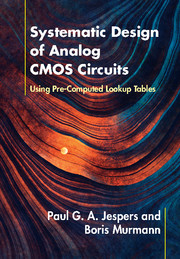Refine search
Actions for selected content:
1562 results in RF and microwave engineering
1 - Introduction
-
- Book:
- Systematic Design of Analog CMOS Circuits
- Published online:
- 28 September 2017
- Print publication:
- 12 October 2017, pp xii-xiv
-
- Chapter
- Export citation
3 - Basic Sizing Using the gm/ID Methodology
-
- Book:
- Systematic Design of Analog CMOS Circuits
- Published online:
- 28 September 2017
- Print publication:
- 12 October 2017, pp 21-61
-
- Chapter
- Export citation
Appendix 1 - The EKV Parameter Extraction Algorithm
-
- Book:
- Systematic Design of Analog CMOS Circuits
- Published online:
- 28 September 2017
- Print publication:
- 12 October 2017, pp 226-291
-
- Chapter
- Export citation

Systematic Design of Analog CMOS Circuits
- Using Pre-Computed Lookup Tables
-
- Published online:
- 28 September 2017
- Print publication:
- 12 October 2017

Measurement Techniques for Radio Frequency Nanoelectronics
-
- Published online:
- 21 September 2017
- Print publication:
- 14 September 2017
3 - Extreme Impedance Measurements
-
- Book:
- Measurement Techniques for Radio Frequency Nanoelectronics
- Published online:
- 21 September 2017
- Print publication:
- 14 September 2017, pp 11-35
-
- Chapter
- Export citation
10 - Measurement of Active Nanoelectronic Devices
-
- Book:
- Measurement Techniques for Radio Frequency Nanoelectronics
- Published online:
- 21 September 2017
- Print publication:
- 14 September 2017, pp 149-186
-
- Chapter
- Export citation
Acknowledgments
-
- Book:
- Measurement Techniques for Radio Frequency Nanoelectronics
- Published online:
- 21 September 2017
- Print publication:
- 14 September 2017, pp vii-xi
-
- Chapter
- Export citation
Index
-
- Book:
- Measurement Techniques for Radio Frequency Nanoelectronics
- Published online:
- 21 September 2017
- Print publication:
- 14 September 2017, pp 279-306
-
- Chapter
- Export citation
8 - Probe-Based Measurement Systems
-
- Book:
- Measurement Techniques for Radio Frequency Nanoelectronics
- Published online:
- 21 September 2017
- Print publication:
- 14 September 2017, pp 104-122
-
- Chapter
- Export citation
Contents
-
- Book:
- Measurement Techniques for Radio Frequency Nanoelectronics
- Published online:
- 21 September 2017
- Print publication:
- 14 September 2017, pp i-vi
-
- Chapter
- Export citation
Abbreviations
-
- Book:
- Measurement Techniques for Radio Frequency Nanoelectronics
- Published online:
- 21 September 2017
- Print publication:
- 14 September 2017, pp xii-xii
-
- Chapter
- Export citation
4 - On-Wafer Measurements of RF Nanoelectronic Devices
-
- Book:
- Measurement Techniques for Radio Frequency Nanoelectronics
- Published online:
- 21 September 2017
- Print publication:
- 14 September 2017, pp 36-51
-
- Chapter
- Export citation
5 - Modeling and Validation of RF Nanoelectronic Devices
-
- Book:
- Measurement Techniques for Radio Frequency Nanoelectronics
- Published online:
- 21 September 2017
- Print publication:
- 14 September 2017, pp 52-66
-
- Chapter
- Export citation
14 - Nanoscale Electromagnetic Measurements for Life Science Applications
-
- Book:
- Measurement Techniques for Radio Frequency Nanoelectronics
- Published online:
- 21 September 2017
- Print publication:
- 14 September 2017, pp 251-278
-
- Chapter
- Export citation
11 - Dopant Profiling in Semiconductor Nanoelectronics
-
- Book:
- Measurement Techniques for Radio Frequency Nanoelectronics
- Published online:
- 21 September 2017
- Print publication:
- 14 September 2017, pp 187-202
-
- Chapter
- Export citation
1 - An Introduction to Radio Frequency Nanoelectronics
-
- Book:
- Measurement Techniques for Radio Frequency Nanoelectronics
- Published online:
- 21 September 2017
- Print publication:
- 14 September 2017, pp xiii-xiv
-
- Chapter
- Export citation
12 - Depth Profiling
-
- Book:
- Measurement Techniques for Radio Frequency Nanoelectronics
- Published online:
- 21 September 2017
- Print publication:
- 14 September 2017, pp 203-221
-
- Chapter
- Export citation
2 - Core Concepts of Microwave and RF Measurements
-
- Book:
- Measurement Techniques for Radio Frequency Nanoelectronics
- Published online:
- 21 September 2017
- Print publication:
- 14 September 2017, pp 1-10
-
- Chapter
- Export citation
13 - Dynamics of Nanoscale Magnetic Systems
-
- Book:
- Measurement Techniques for Radio Frequency Nanoelectronics
- Published online:
- 21 September 2017
- Print publication:
- 14 September 2017, pp 222-250
-
- Chapter
- Export citation
